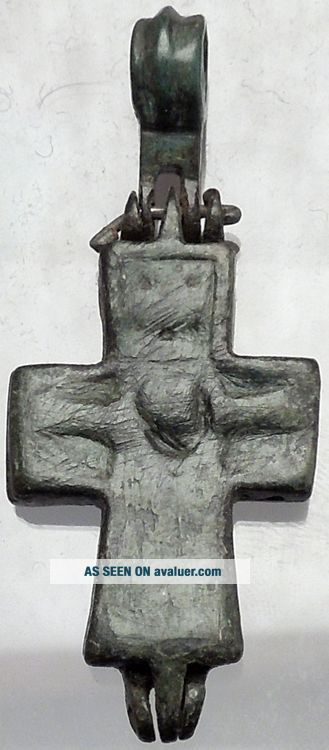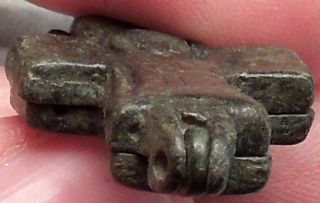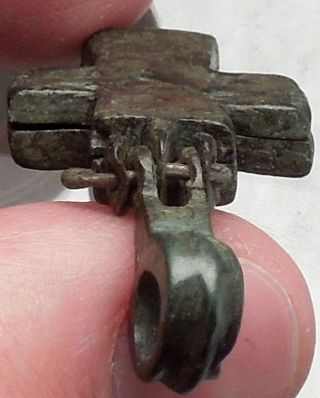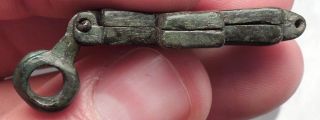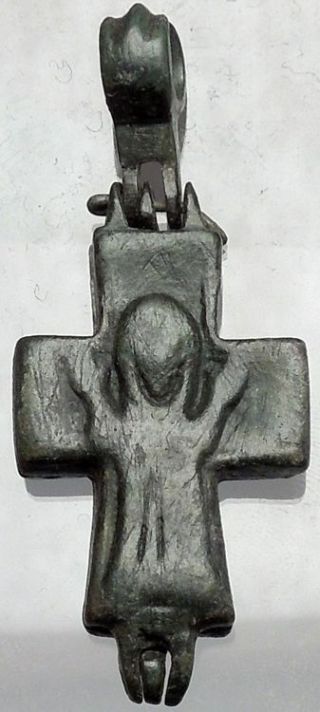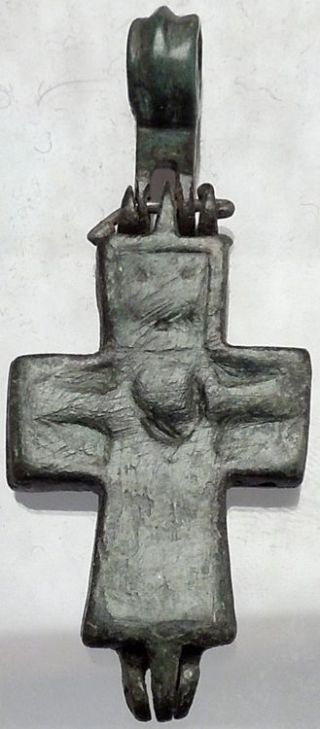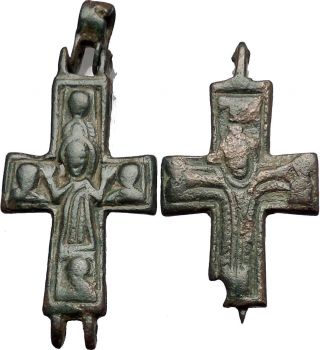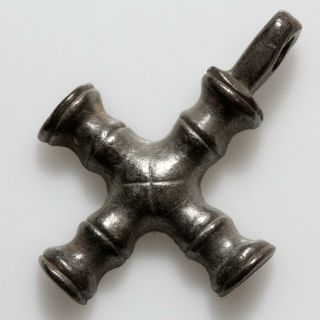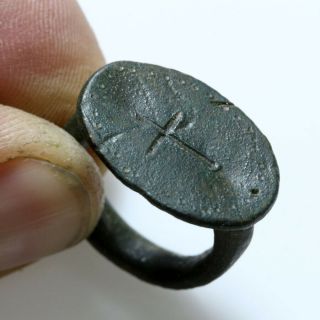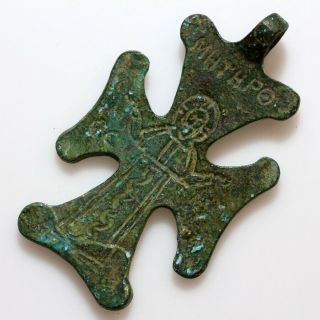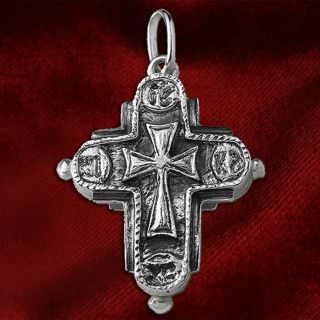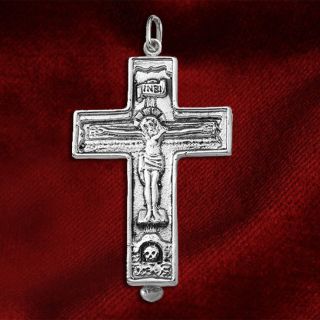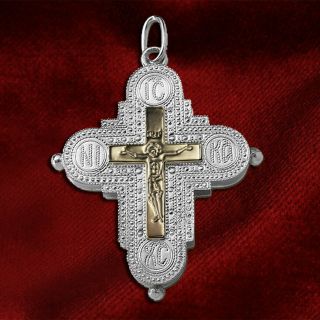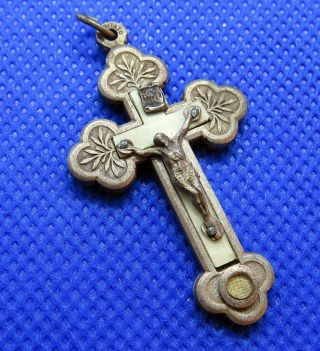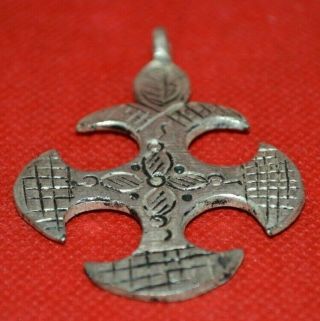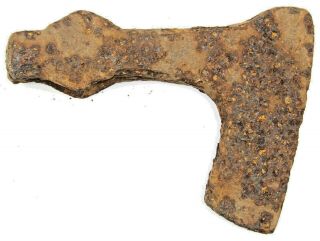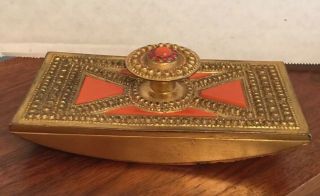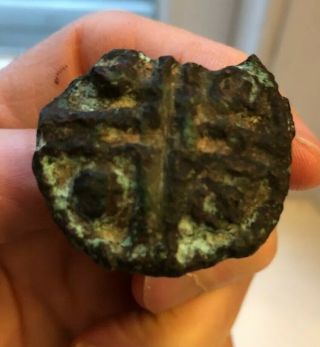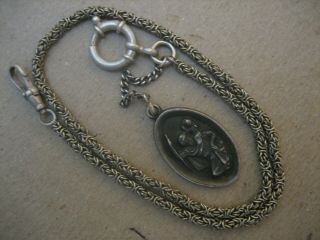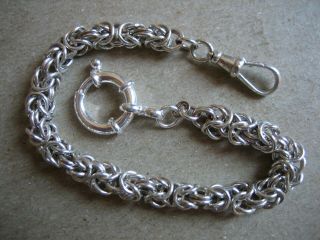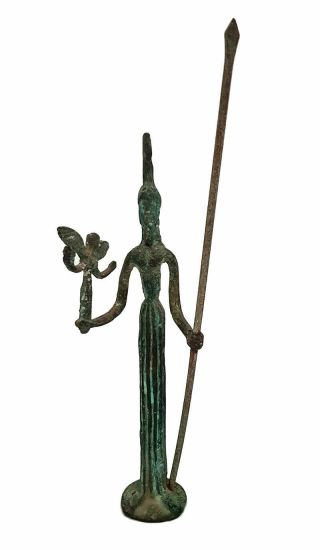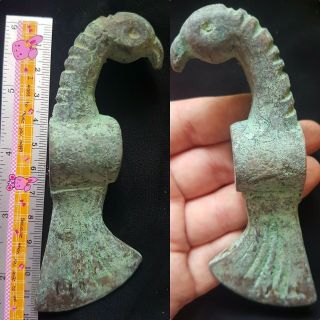Medieval Christian Byzantine Reliquary Cross Crucifix Circa 1000 - 1200AD I49840
Item History & Price
| Reference Number: Avaluer:27438 |
Authentic Ancient Medieval Christian Byzantine Reliquary Cross Crucifix from circa 1000 - 1200 A.D.
4.9 x 2.0 x 0.5 centimeters (14.34 grams)Authentic ancient medieval reliquary Byzantine cross from circa 8...00-1200 A.D. Reliquary crosses are considered to have contained parts of saints or the Holy cross. This one does not have a pin at the bottom, keeping it closed anymore, so there is no relic inside. However because it may have contained a relic, it may still have some of the energies imprinted on it. Amazing religious artifact. The front has a depiction of Jesus Christ and the reverse has Virgin Mary.Provenance: From private collection in the United States of America.
Ownership History: From private collection in the United States, bought in private sale in the United States of America. You are bidding on the exact item pictured, provided with a Certificate of Authenticity and Lifetime Guarantee of Authenticity. Crucifixion is a form of slow and painfulexecution in which the victim is tied or nailed to a large wooden cross and le ft to hang until dead. It is principally known from antiquity, but remains in occasional use in some countries.Thecrucifixion of Jesus is a central event inChristianity, and thecrucifix is the main religious symbol for many churches.The Christian Cross, ✝ seen as a representation of the instrument of thecrucifixion of Jesus, is the best-knownsymbol ofChristianity. It is related to thecrucifix (a cross that includes a usually three-dimensional representation of Jesus' body) and to the more general family of cross symbols.Jesus (Greek:ἸησοῦςIesous; 7–2 BC to 30–33 AD), also referred to as Jesus of Nazareth, is the central figure ofChristianity, whom the teachings of mostChristian denominations hold to be theSon of God. Christianity regards Jesus as the awaited Messiah of theOld Testament and refers to him as Jesus Christ, a name that is also used in non-Christian contexts.Virtually all modern scholars of antiquity agree thatJesus existed historically, although thequest for the historical Jesuss has produced little agreement on the historical reliability of the Gospels and on how closely the biblical Jesus reflects thehistorical Jesus. Most scholars agree that Jesus was a Jewishrabbi fromGalilee who preached his messageorally, was baptized byJohn the Baptist, andwas crucified inJerusalem on the orders of theRoman prefect, Pontius Pilate. Scholars have constructed variousportraits of the historical Jesus, which often depict him as having one or more of the following roles: the leader of anapocalyptic movement, Messiah, a charismatic healer, a sage and philosopher, or anegalitariansocial reformer. Scholars have correlated theNew Testament accounts with non-Christian historical records to arrive at an estimatedchronology of Jesus' life. The most widely usedcalendar era in the world (abbreviated as "AD", alternatively referred to as "CE"), counts froma medieval estimate of the birth year of Jesus.Christians believe that Jesus has a "unique significance" in the world. Christian doctrines include the beliefs that Jesus was conceived by theHoly Spirit, wasborn of a virgin, performedmiracles, foundedthe Church, died by crucifixion as a sacrifice to achieveatonement, rose from the dead, andascended intoheaven, whence hewill return. The great majority of Christians worship Jesus as theincarnation ofGod the Son, the second of threepersons of areject TrinitarianismDivine Trinity, wholly or partly, as non-scriptural.In Islam, Jesus (commonly transliterated asIsa) is considered one ofGod's importantprophets and the Messiah. ToMuslims, Jesus is abringer of scripture and was born of a virgin, but neither the Son of God nor the victim of crucifixion. According to theQuran, Jesuswas not crucified but was physicallyraised into the heavens by God.Judaismrejects the Christian and Islamic belief that Jesus was the awaited Messiah, arguing that he did not fulfill theMessianic prophecies in theTanakh.A reliquaryy (also referred to as a shrine or by the French term châsse) is a container for relics. These may be the purported physical remains of saints, such as bones, pieces of clothing, or some object associated with saints or other religious figures. The authenticity of any given relic is often a matter of debate; for that reason, some churches require documentation of the relic's provenance.Relics have long been important toBuddhists, Christians, Hindus and many other religions. In these cultures, reliquaries are often presented in shrines, churches, or temples to which the faithful makepilgrimages in order to gain blessings. In Central West Africa, reliquaries used in the Bwete rituals contain objects consideredmagical, or the bones of ancestors, and are commonly constructed with a guardian figure attached to the reliquary.[citation needed]The term is sometimes used loosely of containers for the body parts of non-religious figures; in particular theKings of France often specified that their hearts and sometimes other organs be buried in a different location from their main burial.In Christianity A view inside the shrine of Saint Boniface of Dokkum in the hermit-church of Warfhuizen in the Netherlands . The little folded paper on the left contains a bone-fragment of Saint Benedict of Nursia , the folded paper on the right a piece of the habit of Saint Bernard of Clairvaux . The large bone in the middle (about 5 cm. in length) is the actual relic of Saint Boniface. The use of reliquaries became an important part ofChristian practices from at least the 4th century, initially in theEastern church, which adopted the practice of moving and dividing the bodies of saints much earlier than the West, probably in part because the new capital ofConstantinople, unlike Rome, lacked buried saints. Relics are venerated in theOriental Orthodox, Eastern Orthodox, Roman Catholic and someAnglican Churches. Reliquaries provide a means of protecting and displaying relics. While frequently taking the form of caskets, they range in size from simple pendants or rings to very elaborateossuaries.Since the relics themselves were considered "more valuable than precious stones and more to be esteemed than gold, " it was only appropriate that they be enshrined containers crafted of or covered with gold, silver, gems, and enamel. Ivory was widely used in the Middle Ages for reliquaries; its pure white color an indication of the holy status of its contents. These objects constituted a major form of artistic production across Europe and Byzantium throughout the Middle Ages.Many were designed with portability in mind, often being exhibited in public or carried inprocession on the saint'sfeast day or on otherholy days.Pilgrimages often centered around theveneration of relics. The faithful often venerate relics by bowing before the reliquary or kissing it. Those churches which observe the veneration of relics make a clear distinction between the honor given to the saints and the worship that is due to God alone (seeSecond Council of Nicea). The feretrum was a medieval form of reliquary orshrine containing the sacredeffigies and relics of a saint. In the late Middle Ages the craze for relics, many now fraudulent, became extreme, and was criticized by many otherwise conventional churchmen.16th-century reformers such asMartin Luther opposed the use of relics since many had no proof of historic authenticity, and they objected to the cult of saints. Many reliquaries, particularly in northern Europe, were destroyed byCalvinists or Calvinist sympathizers during theReformation, being melted down or pulled apart to recover precious metals and gems. Nonetheless, the use and manufacture of reliquaries continues to this day, especially inRoman Catholic andOrthodox Christian countries. Post-Reformation reliquaries have tended to take the form of glass-sided caskets to display relics such as the bodies of saints.FormsThe earliest reliquaries were essentially boxes, either simply box-shaped or based on an architectural design, taking the form of a model of a church with a pitched roof. These latter are known by the French termchasse, and typical examples from the 12th to 14th century have wooden frameworks withgilt-copper plaques nailed on, decorated inchamplevé enamel.Limoges was the largest centre of production; NB the English usage differs from that of the French châsse, which denotes large size rather than shape. Franco-Flemish Gothic philatory for a finger bone, late 15th century (Walters Art Museum) Relics of theTrue Cross became very popular from the 9th century onwards and were housed in magnificent gold and silver cross-shaped reliquaries, decorated with enamels and precious stones. From about the end of the 10th century, reliquaries in the shape of the relics they housed also became popular; hence, for instance, Pope Alexander I's skull was housed in a head-shaped reliquary. Similarly, the bones of saints were often housed in reliquaries that recalled the shape of the original body part, such as an arm or a foot.A philatory is a transparent reliquary designed to contain and exhibit the bones and relics of saints. This style of reliquary has a viewing portal by which to view the relic contained inside.During the laterMiddle Ages, themonstrance form, mostly used for consecrated hosts, was sometimes used for reliquaries. These housed the relic in a rock crystal or glass capsule mounted on a column above a base, enabling the relic to be displayed to the faithful. Reliquaries in the form of large pieces of metalwork jewellery also appeared around this time, housing tiny relics such as pieces of theHoly Thorn. Box Reliquary/Chasse: Gilded reliquary St. Taurin Arm Reliquary Head Reliquary Icon of St. Guriy of Kazan, with relic embedded in it (19th century). Frequently Asked Questions How long until my order is shipped?
Depending on the volume of sales, it may take up to 5 business days forshipment of your order after the receipt of payment. How will I know when the order was shipped?
After your order has shipped, you will be left positive feedback, and thatdate should be used as a basis of estimating an arrival date. After you shipped the order, how long will the mail take?
USPS First Class mail takes about 3-5 business days to arrive in the U.S., international shipping times cannot be estimated as they vary from countryto country. I am not responsible for any USPS delivery delays, especiallyfor an international package. What is a certificate of authenticity and what guarantees do you givethat the item is authentic?
Each of the items sold here, is provided with a Certificate of Authenticity, and a Lifetime Guarantee of Authenticity, issued by a world-renowned numismatic and antique expert that has identified over 10000 ancient coins and has provided themwith the same guarantee. You will be quite happy with what you get with the COA; a professional presentation of the coin, with all of the relevantinformation and a picture of the coin you saw in the listing. Compared to other certification companies, the certificate of authenticity is a $25-50 value. So buy a coin today and own a piece of history, guaranteed. Is there a money back guarantee?
I offer a 30 day unconditional money back guarantee. I stand behind my coins and would be willing to exchange your order for either store credit towards other coins, or refund, minus shipping expenses, within 30 days from the receipt of your order. My goal is to have the returning customers for a lifetime, and I am so sure in my coins, their authenticity, numismatic value and beauty, I can offer such a guarantee. Is there a number I can call you with questions about my order? You can contact me directly via ask seller a question and request my telephone number, or go to my About Me Page to get my contact information only in regards to items purchased on eBay. When should I leave feedback?
Once you receive your order, please leave a positive. Please don't leave anynegative feedbacks, as it happens many times that people rush to leavefeedback before letting sufficient time for the order to arrive. Also, ifyou sent an email, make sure to check for my reply in your messages beforeclaiming that you didn't receive a response. The matter of fact is that anyissues can be resolved, as reputation is most important to me. My goal is toprovide superior products and quality of service.
03186



